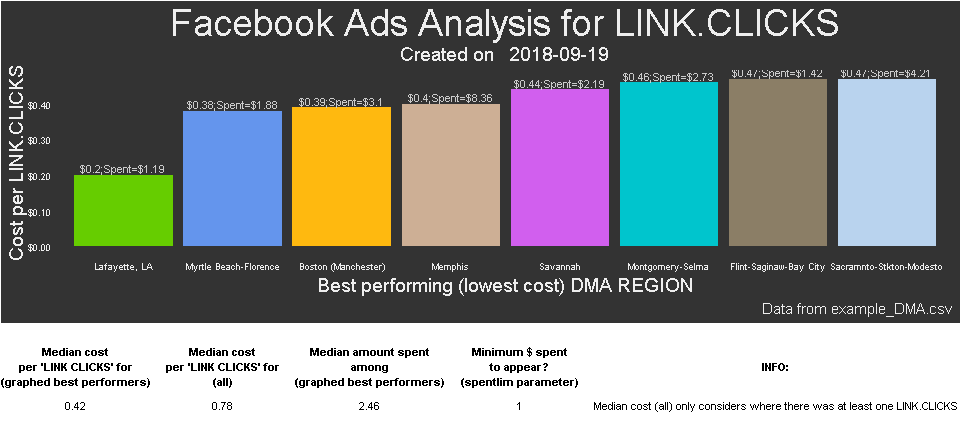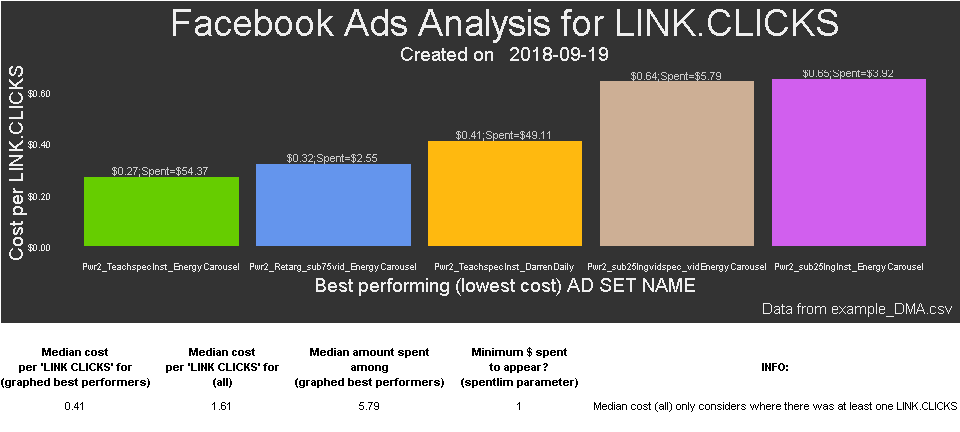[Currently includes $30k of real Facebook Ads data for marketing that supported the online coaching business, "Impackt Squared". Revenue-associated data are too limited to be interesting but other performance data like link clicks can be analyzed]
FBadstats is an R Package for generating statistics from Facebook ads performance data. Assists with ad targeting by aggregating data across multiple ad sets or campaigns in an attractive way. Works with many kinds of column selections from Facebook Ads Manager including Campaign, Ad Set, and Ad primary views. Currently only includes the breakdown Group analyzer function FBadGstats.
Disclaimer: This function and the entire FBadstats package are not supported or endorsed by Facebook, Inc. Only the user is responsible for its use.
First install the free (open-source) statistical software (and language) named "R" at: http://cran.rstudio.com/
Then download the most popular software to make using R easier, RStudio. The free version will be perfect. Scroll down and choose the appropriate installer under Installers for Supported Platforms at: https://www.rstudio.com/products/rstudio/download/
Open RStudio and you can now install the FBadstats package from github by entering the following in RStudio:
## This first package is to enable the install_github function
install.packages("devtools")
## Now we can always load that package with
library("devtools")
## Install FBadstats
devtools::install_github("RickPack/FBadstats")The easiest use is to call the function, navigate to your exported CSV file and then select it. The default parameters may give you all you need.
FBadGstats()You can select a folder and process all of the .CSV files with:
FBadGstats(choosedir=TRUE)## Load FBadstats
library("FBadstats")
# Show only the best performing groups and include the graphical output,
# minimum spend to appear is a dollar ($1), analyzed result is Unique CTR (Link Click-Through Rate)
FBadGstats(filerd = "example_DMA.csv", grphout = TRUE, tblout = "BEST",
spentlim = 1, sumvar = 'LINK.CLICKS')
#> early1_2
#> early3
#> Joining, by = "DMA.REGION"
#> [1] "-------------------------------------------------------------"
#> [1] "BEST: LINK CLICKS in example_DMA.csv"
#> # A tibble: 20 x 5
#> DMA.REGION rnkevent sumevent costevent sumspent
#> <chr> <int> <dbl> <dbl> <dbl>
#> 1 Lafayette, LA 1 6 0.2 1.19
#> 2 Myrtle Beach-Florence 2 5 0.38 1.88
#> 3 Boston (Manchester) 3 8 0.39 3.1
#> 4 Memphis 4 21 0.4 8.36
#> 5 Savannah 5 5 0.44 2.19
#> 6 Montgomery-Selma 6 6 0.46 2.73
#> 7 Flint-Saginaw-Bay City 7 3 0.47 1.42
#> 8 Sacramnto-Stkton-Modesto 7 9 0.47 4.21
#> 9 Cleveland-Akron (Canton) 9 10 0.54 5.43
#> 10 Shreveport 9 3 0.54 1.62
#> 11 Atlanta 11 45 0.56 25.1
#> 12 Las Vegas 11 4 0.56 2.24
#> 13 San Antonio 11 2 0.56 1.12
#> 14 St. Louis 11 8 0.56 4.49
#> 15 Tallahassee-Thomasville 11 3 0.56 1.67
#> 16 Minneapolis-St. Paul 16 2 0.59 1.18
#> 17 Baltimore 17 12 0.6 7.26
#> 18 Indianapolis 18 6 0.61 3.68
#> 19 Portland, OR 19 2 0.62 1.25
#> 20 Greensboro-H.Point-W.Salem 20 10 0.63 6.29
#> [1] "Number of groups in all of data: 197"
#> [1] "Number of DMA REGION groups with at least one LINK CLICKS and minimum spend of $1 = 63"
#> [1] "Total amount spent: $420.75"
#> markerbottom_1
#> Joining, by = "AD.SET.NAME"#> [1] "-------------------------------------------------------------"
#> [1] "BEST: LINK CLICKS in example_DMA.csv"
#> # A tibble: 20 x 5
#> AD.SET.NAME rnkevent sumevent costevent sumspent
#> <chr> <int> <dbl> <dbl> <dbl>
#> 1 Pwr2_TeachspecInst_EnergyCarousel 1 199 0.27 54.4
#> 2 Pwr2_Retarg_sub75vid_EnergyCarous~ 2 8 0.32 2.55
#> 3 Pwr2_TeachspecInst_DarrenDaily 3 119 0.41 49.1
#> 4 Pwr2_sub25lngvidspec_vidEnergyCar~ 4 9 0.64 5.79
#> 5 Pwr2_sub25lngInst_EnergyCarousel 5 6 0.65 3.92
#> 6 Pwr2_MercerInst_EnergyCarousel 6 14 0.87 12.2
#> 7 ProBook_Pg_95vidlk 7 67 0.98 65.3
#> 8 Pwr2_RTP4562_vidEnergyCarousel 8 12 1.07 12.9
#> 9 ProBook_Pg_TeachSpec 9 3 1.11 3.32
#> 10 Pwr2_sub25lngvid40+_vidEnergyCaro~ 10 11 1.36 15.0
#> 11 Pwr2_sub25lngvidInst_vidEnergyCar~ 11 1 1.48 1.48
#> 12 Pwr2_sub75vid_DarrenDaily 12 3 1.61 4.84
#> 13 Pwr2_TeachSpecRTP_vidEnergyCarous~ 13 5 1.65 8.25
#> 14 Pwr2_sub95vidInst_EnergyCarousel 14 2 1.71 3.42
#> 15 Vid_DHardy1_Iyanla 15 19 1.84 35.0
#> 16 Event: Ryan's Race for 1st Place_~ 16 1 2.19 2.19
#> 17 Pwr2_Teachspec_vidEnergyCarousel 17 2 2.29 4.57
#> 18 Pwr2_TeachSpecDT_vidEnergyCarousel 18 3 2.6 7.81
#> 19 Pwr2_Teach95vidRTP_vidEnergyCarou~ 19 1 2.92 2.92
#> 20 ProBook_Pg_TeachLk 20 1 3.02 3.02
#> [1] "Number of groups in all of data: 36"
#> [1] "Number of AD SET NAME groups with at least one LINK CLICKS and minimum spend of $1 = 23"
#> [1] "Total amount spent: $420.75"
#> markerbottom_1
Here we see BOTH [default for tblout parameter] the top 3 and worst 3 Age / Gender groups in a comparison between where "6txt" did (parameter filtervar = "hotreg") and did not (parameter filtervarneg = "hotreg") appear in the ad set name.
At least two events (clicks) must have occurred. Otherwise, an anomalous single event for 25-34 males caused that group to appear.
"Hotreg" indicated where selected regions with a history of performing well were the only ones targeted with the advertisement.
FBadGstats(filerd = "example_PerfClk_AgeGender.csv", filtervar = 'hotreg', printrow = 3, minevent = 2, grphout = FALSE)
#> early1_2
#> early3
#> Joining, by = "AGE_GENDER"
#> [1] "-------------------------------------------------------------"
#> [1] "WORST: RESULTS in example_PerfClk_AgeGender.csv"
#> # A tibble: 3 x 5
#> AGE_GENDER rnkevent sumevent costevent sumspent
#> <chr> <int> <dbl> <dbl> <dbl>
#> 1 35-44:female 3 40 1.91 76.3
#> 2 25-34:female 2 30 1.53 45.9
#> 3 35-44:male 1 11 0.14 1.55
#> [1] "BEST: RESULTS in example_PerfClk_AgeGender.csv"
#> # A tibble: 3 x 5
#> AGE_GENDER rnkevent sumevent costevent sumspent
#> <chr> <int> <dbl> <dbl> <dbl>
#> 1 35-44:male 1 11 0.14 1.55
#> 2 25-34:female 2 30 1.53 45.9
#> 3 35-44:female 3 40 1.91 76.3
#> [1] "Number of groups in all of data: 6"
#> [1] "Number of AGE_GENDER groups with at least one RESULTS and minimum spend of $0 = 3"
#> [1] "Total amount spent: $125.76"
#> markerbottom_1
#> Joining, by = "AD.SET.NAME"
#> [1] "-------------------------------------------------------------"
#> [1] "WORST: RESULTS in example_PerfClk_AgeGender.csv"
#> # A tibble: 2 x 5
#> AD.SET.NAME rnkevent sumevent costevent sumspent
#> <chr> <int> <dbl> <dbl> <dbl>
#> 1 ProBook_SendLaneB2544hotreg 2 3 2.37 7.1
#> 2 ProBook_xPg_SendLane2544hotreg 1 80 1.48 118.
#> [1] "BEST: RESULTS in example_PerfClk_AgeGender.csv"
#> # A tibble: 2 x 5
#> AD.SET.NAME rnkevent sumevent costevent sumspent
#> <chr> <int> <dbl> <dbl> <dbl>
#> 1 ProBook_xPg_SendLane2544hotreg 1 80 1.48 118.
#> 2 ProBook_SendLaneB2544hotreg 2 3 2.37 7.1
#> [1] "Number of groups in all of data: 3"
#> [1] "Number of AD SET NAME groups with at least one RESULTS and minimum spend of $0 = 2"
#> [1] "Total amount spent: $125.76"
#> markerbottom_1
FBadGstats(filerd = "example_PerfClk_AgeGender.csv", filtervarneg = 'hotreg', printrow = 3, minevent = 2, grphout = FALSE)
#> early1_2
#> early3
#> Joining, by = "AGE_GENDER"
#> [1] "-------------------------------------------------------------"
#> [1] "WORST: RESULTS in example_PerfClk_AgeGender.csv"
#> # A tibble: 3 x 5
#> AGE_GENDER rnkevent sumevent costevent sumspent
#> <chr> <int> <dbl> <dbl> <dbl>
#> 1 45-54:female 5 41 1.52 62.3
#> 2 25-34:female 4 41 1.39 57.1
#> 3 35-44:female 3 68 1.29 87.9
#> [1] "BEST: RESULTS in example_PerfClk_AgeGender.csv"
#> # A tibble: 3 x 5
#> AGE_GENDER rnkevent sumevent costevent sumspent
#> <chr> <int> <dbl> <dbl> <dbl>
#> 1 18-24:female 1 10 0.84 8.42
#> 2 55-64:female 2 34 1.2 40.8
#> 3 35-44:female 3 68 1.29 87.9
#> [1] "Number of groups in all of data: 14"
#> [1] "Number of AGE_GENDER groups with at least one RESULTS and minimum spend of $0 = 5"
#> [1] "Total amount spent: $258.62"
#> markerbottom_1
#> Joining, by = "AD.SET.NAME"
#> [1] "-------------------------------------------------------------"
#> [1] "WORST: RESULTS in example_PerfClk_AgeGender.csv"
#> # A tibble: 3 x 5
#> AD.SET.NAME rnkevent sumevent costevent sumspent
#> <chr> <int> <dbl> <dbl> <dbl>
#> 1 ProBook_Pg_LkDev75k+_5562 7 6 2.13 12.8
#> 2 ProBook_Pg_LkDev75k+_3544 6 28 2.05 57.4
#> 3 ProBook_AllPg_75kAccSeLaneReg 5 11 1.67 18.4
#> [1] "BEST: RESULTS in example_PerfClk_AgeGender.csv"
#> # A tibble: 3 x 5
#> AD.SET.NAME rnkevent sumevent costevent sumspent
#> <chr> <int> <dbl> <dbl> <dbl>
#> 1 ProBook_Pg_LeadSendLkUKSA 1 71 0.61 43.0
#> 2 ProBook_Pg_50kLeadSendLkUKSA 2 17 1.22 20.8
#> 3 ProBook_xPg_6txt_SendLane2544 3 11 1.37 15.0
#> [1] "Number of groups in all of data: 10"
#> [1] "Number of AD SET NAME groups with at least one RESULTS and minimum spend of $0 = 7"
#> [1] "Total amount spent: $258.62"
#> markerbottom_1Advanced Example 3/3 (Assign FBadGstats call to a variable in order to explore the data outside of FBadGstats)
A list is returned so use [[1]] for breakdown groups and [[2]] for Campaign, Ad, or Ad Set, one of which being automatically detected based on the inputfile
myfbfrm <- FBadGstats(filerd = "Example_AdsView_Region.csv", filtervar = 'Teach', grphout = FALSE)
#> early1_2
#> early3
#> Joining, by = "IMPRESSION.DEVICE"
#> [1] "-------------------------------------------------------------"
#> [1] "WORST: RESULTS in Example_AdsView_Region.csv"
#> # A tibble: 3 x 5
#> IMPRESSION.DEVICE rnkevent sumevent costevent sumspent
#> <chr> <int> <dbl> <dbl> <dbl>
#> 1 Android Smartphone 3 14 0.64 9
#> 2 iPhone 2 11 0.51 5.61
#> 3 Android Tablet 1 1 0.09 0.09
#> [1] "BEST: RESULTS in Example_AdsView_Region.csv"
#> # A tibble: 3 x 5
#> IMPRESSION.DEVICE rnkevent sumevent costevent sumspent
#> <chr> <int> <dbl> <dbl> <dbl>
#> 1 Android Tablet 1 1 0.09 0.09
#> 2 iPhone 2 11 0.51 5.61
#> 3 Android Smartphone 3 14 0.64 9
#> [1] "Number of groups in all of data: 7"
#> [1] "Number of IMPRESSION DEVICE groups with at least one RESULTS and minimum spend of $0 = 3"
#> [1] "Total amount spent: $15.23"
#> markerbottom_1
#> Joining, by = "AD.NAME"
#> [1] "-------------------------------------------------------------"
#> [1] "WORST: RESULTS in Example_AdsView_Region.csv"
#> # A tibble: 2 x 5
#> AD.NAME rnkevent sumevent costevent sumspent
#> <chr> <int> <dbl> <dbl> <dbl>
#> 1 ProBook1_Teach 2 16 0.85 13.6
#> 2 Div_Pwr_Teach100k+_AllD 1 10 0.16 1.64
#> [1] "BEST: RESULTS in Example_AdsView_Region.csv"
#> # A tibble: 2 x 5
#> AD.NAME rnkevent sumevent costevent sumspent
#> <chr> <int> <dbl> <dbl> <dbl>
#> 1 Div_Pwr_Teach100k+_AllD 1 10 0.16 1.64
#> 2 ProBook1_Teach 2 16 0.85 13.6
#> [1] "Number of groups in all of data: 2"
#> [1] "Number of AD NAME groups with at least one RESULTS and minimum spend of $0 = 2"
#> [1] "Total amount spent: $15.23"
#> markerbottom_1
## What are all of the available ad set names?
# 1. First look at the column names in the data
colnames(myfbfrm)
#> [1] "REPORTING.STARTS"
#> [2] "REPORTING.ENDS"
#> [3] "AD.NAME"
#> [4] "IMPRESSION.DEVICE"
#> [5] "DELIVERY"
#> [6] "AMOUNT.SPENT..USD."
#> [7] "UNIQUE.CTR..LINK.CLICK.THROUGH.RATE."
#> [8] "RELEVANCE.SCORE"
#> [9] "CTR..ALL."
#> [10] "CTR..LINK.CLICK.THROUGH.RATE."
#> [11] "VIDEO.PERCENTAGE.WATCHED"
#> [12] "POST.REACTIONS"
#> [13] "POST.COMMENTS"
#> [14] "POST.SHARES"
#> [15] "POSITIVE.FEEDBACK"
#> [16] "LINK.CLICKS"
#> [17] "WEBSITE.REGISTRATIONS.COMPLETED"
#> [18] "WEBSITE.LEADS"
#> [19] "WEBSITE.PURCHASES"
#> [20] "WEBSITE.CHECKOUTS.INITIATED.CONVERSION.VALUE"
#> [21] "WEBSITE.ADDS.TO.WISHLIST"
#> [22] "WEBSITE.CHECKOUTS.INITIATED"
#> [23] "WEBSITE.SEARCHES"
#> [24] "VIDEO.WATCHES.AT.50."
#> [25] "VIDEO.WATCHES.AT.75."
#> [26] "REACH"
#> [27] "RESULTS"
#> [28] "RESULT.INDICATOR"
#> [29] "X3.SECOND.VIDEO.VIEWS"
#> [30] "VIDEO.AVERAGE.WATCH.TIME"
#> [31] "BUTTON.CLICKS"
#> [32] "BYGRPVAR"
#> [33] "S1"
#> [34] "V1"
# 2. Now we can use the unique function to see all of the available names and appropriately adjust the filtervar parameter
unique(myfbfrm$AD.NAME)
#> [1] "ProBook1_Teach" "Div_Pwr_Teach100k+_AllD"Note: See more examples by entering in RStudio:
vignette(package = "FBadstats")Thank you to Brian Fannin, Ari Lamstein, and Lucia Gjeltema for your feedback and encouragement.



